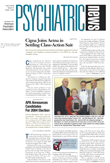All American psychiatrists know the name Benjamin Rush (1745-1813). He is recognized as the father of American psychiatry, and his likeness and name are the centerpiece of APA’s logo.
But this leading American colonist was far more than the nation’s first psychiatrist. In 1789 he wrote the first American psychiatric textbook, Medical Inquiries and Observations on Diseases of the Mind. He also was a signer of the Declaration of Independence, a surgeon in the Continental Army during the American Revolution, a member of the Continental Congress, and a professor at the medical school in Philadelphia.
Rush’s biographies and autobiography portray him as a strong-willed, opinionated man but with kindly and philanthropic ways—a man of integrity who was devoted to his family.
After obtaining his medical degree at Edinburgh and making trips to London and Paris, Rush returned to America in 1769. He set up his medical practice in Philadelphia and became engaged to Sarah Eve, but she died of tuberculosis three weeks before their scheduled wedding.
The following year he became engaged to Julia Stockton, whose family he knew during his undergraduate days at Princeton. They were married on January 11, 1775. Julia was 16, Rush 30.
During their engagement year, Rush wrote frequently to Julia describing his daily activities and professing his love. He wrote, “I desire no other happiness than heaven and you,” and “how soft a pillow is the bosom of a female friend,” and “you possess everything that my most romantic ideas of perfection in women ever suggested to me.”
In one letter, Rush gave an eight-degree scale for conjugal happiness that began with sympathy in manners, opinions, tastes, sentiments, understandings, tempers, and religion.
In his autobiography, Rush wrote, “She fulfilled every duty as a wife, mother, and mistress with fidelity and integrity. . .a sincere and honest friend. Had I yielded to her advice on many occasions, I should have known less distress.”
The couple had 13 children, nine of whom survived to adulthood. John, the oldest, became a physician, entered the Navy, and soon after became mentally deranged. He died while under care for his mental disorder. Anne, the second child, married a Canadian and moved to his home country.
Son Richard attained the greatest distinction, becoming Pennsylavania attorney general and later comptroller of the U.S. Treasury and minister to Great Britain and France.
The next two children, girls, died in infancy. Mary, the sixth, married an Englishman and lived in Canada and England. James, a physician, married a Philadelphia heiress and retired to follow his literary and scientific interests. Rush’s eighth and ninth children were boys who died in infancy.
The remaining children were Benjamin, who died at age 30 in New Orleans unmarried; Julia, who married a Philadelphia lawyer; Samuel, a Philadelphia lawyer; and William, also a physician.
Of Julia’s life during her marriage, only snippets have been revealed. In 1809, accompanied by her daughter Julia, Mrs. Rush traveled to Canada to visit her daughter living there. Rush’s mother lived with the family during her last year (she died at age 75) and expressed her affection for Julia and gratitude for her kindness and attention.
A footnote in Rush’s autobiography says, “The memory of Julia Stockton Rush lives almost exclusively in the autobiography. She raised her family in a time of war, pestilence, and great economic stress; she had little time for anything but the care of her family. It is evident that she was a sensible, calm woman upon whom [Rush] depended for solace and stabilizing advice.”
The year before his death, Rush wrote a poem to Julia. It ended, “and when the stream of time shall end, and the last trump my grave shall rend, who shall with me to heaven ascend, my Julia.”
Portraits of Benjamin and Julia Rush painted in 1776 by Charles Willson Peale hang in the Winterthur museum near Wilmington, Del. ▪
